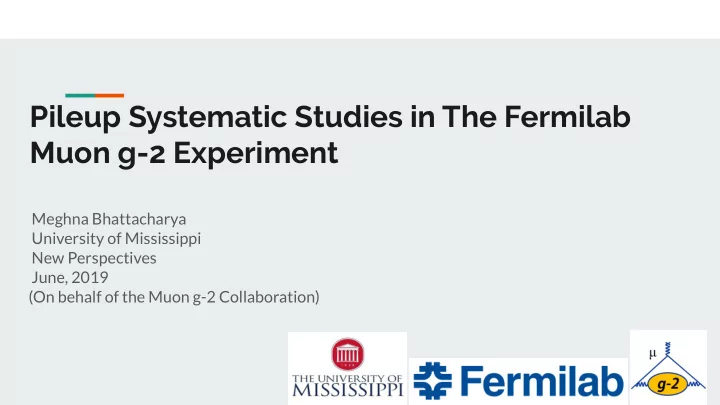

Pileup Systematic Studies in The Fermilab Muon g-2 Experiment Meghna Bhattacharya University of Mississippi New Perspectives June, 2019 (On behalf of the Muon g-2 Collaboration)
Muon g-2 Experimental Hall at Fermilab 2
Measurement of Muon Cyclotron frequency : ❖ ❖ Muon spin precession frequency : ❖ Experimentally measured : Anomalous precession frequency: ➢ (Ideally) ➢ Magnetic field: For more details: Jason Hempstead (Muon g-2 in 10 minutes) 3
Extracting (Using Threshold Method) ● Highest-energy emitted preferentially along muon spin (Energy Cut > 1.7 GeV) ● Results in sinusoidally-oscillating arrival time of these in calorimeters 4
More precise this time! ● Increase the statistics by a factor of 21 and reduce systematics by a factor of ~ 3 w.r.t BNL experiment 5
Pileup events Energy spectra from all detectors Two (or more) decay positrons hit a calorimeter too close in space and time 2 The overlapping pulses are treated as a single pulse of higher energy(pileup events) Pileup events distort the time (carries a different g-2 phase) and Evidence of two or more overlapping events energy spectra 6
Pileup construction Form doublets by looking in “shadow” windows for ❖ shadow pulses The energy of the doublet is ❖ The time of the doublets are approximated as ❖ Pileup spectrum = Doublets-Singlets ❖ 7
Pileup construction Original Energy Pileup energy spectrum = Doublets - Singlets Positive pileup Negative Pileup 8
Pileup Correction Ratio Ratio = pileup spectrum / original energy Original Energy Pileup Spectrum Corrected Spectrum = Original Energy - Pileup Energy (MeV) Ratio -> Consistent with 1 if constructed correctly ● Higher order pileup contamination around 5 GeV ● 9
Pileup Time Spectra Uncorrected Wiggle spectrum Pileup Spectrum Preliminary Results Preliminary Results 10
Conclusion Muon g-2 experiment has completed run 1 and we are currently analyzing the data ● Pileup is one of the most important source of systematic uncertainties to the anomalous spin ● precession frequency measurement Next step is to evaluate the systematic uncertainty coming from the Pileup events and finally ● estimate the error 11
Backup Why 1.7 GeV 12
SM Contributions QED correction: by far the largest one....well understood EW contribution: the uncertainty is much smaller than the hadronic sector Hadronic sector: The uncertainty is dominated by the hadronic contribution and challenges the Theory community 13
Doubles and single energy spectra Doubles Trigger pulse Shadow Pulse 14
Measurement of In E821 (0.54 ppm) Get from CODATA [1]: (0.00026 ppb) (22 ppb) (3.0 ppb) [1]. P. J. Mohr, D. B. Newell and B. N. Taylor, Rev. Mod. Phys. 88 , no. 3, 035009 (2016), doi:10.1103/RevModPhys.88.035009 [arXiv:1507.07956 15 [physics.atom-ph]]
More Precise this time! Increase the statistics by a factor of 21 and reduce systematics by a factor of ~ 3 w.r.t BNL experiment More Statistics Better uniform magnetic field 40 ppb Pileup Much smaller systematic errors 16
What is g? A charged elementary particle with half-integer intrinsic spin has magnetic ❖ dipole moment aligned with its spin : According to Dirac's theory = 2 ❖ 1947: Schwinger showed...the lowest order radiative correction to the ❖ electron spin magnetic moment results in , = 2.00238(6) Agreed well with the experiments and that is how we build confidence in new physics model Schwinger term describing 1st order electron self-interaction 17
Pileup Time Spectra Construction = 1.7 GeV Chart of Doublets : number of pileup events • > 1.7 GeV (threshold ) • For N1 : gain a count in the time spectrum • For N4 : lose a count, because both singlets were above threshold • N2 , N3 : no net change of counts (only one singlet > 1.7 GeV) 18
Why measure ? ❖ Contributions to come from all sectors of the Standard Model Greater than between the BNL measurement and current theory ❖ prediction Sensitive to many new models ❖ 19
Status Quo (Theory Total) (World average) discrepancy [1] FNAL Physics BSM? Hint of New Physics? 0.54 ppm (BNL) 0.14 ppm (FNAL Goal) 20 [ 1] KNT2018, arXiv:1802.02995v1 [hep-ph]
Recommend
More recommend